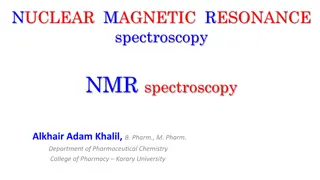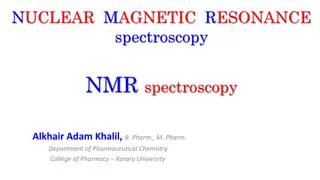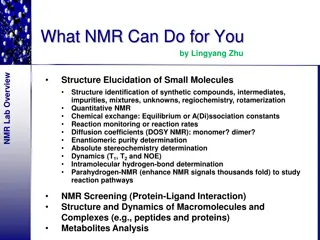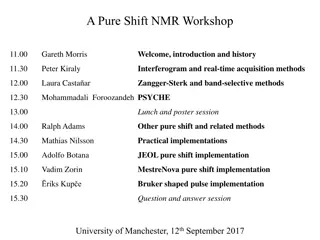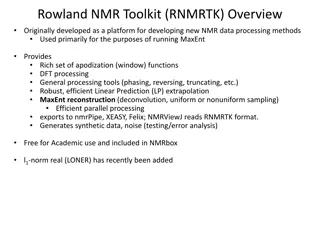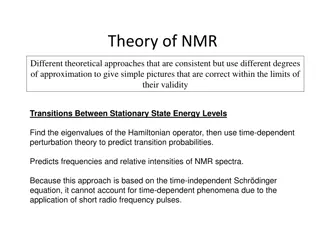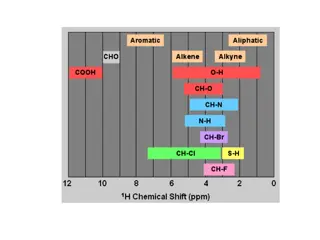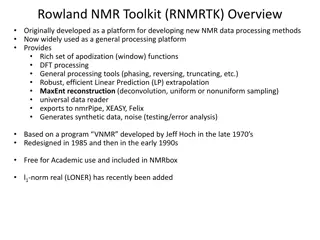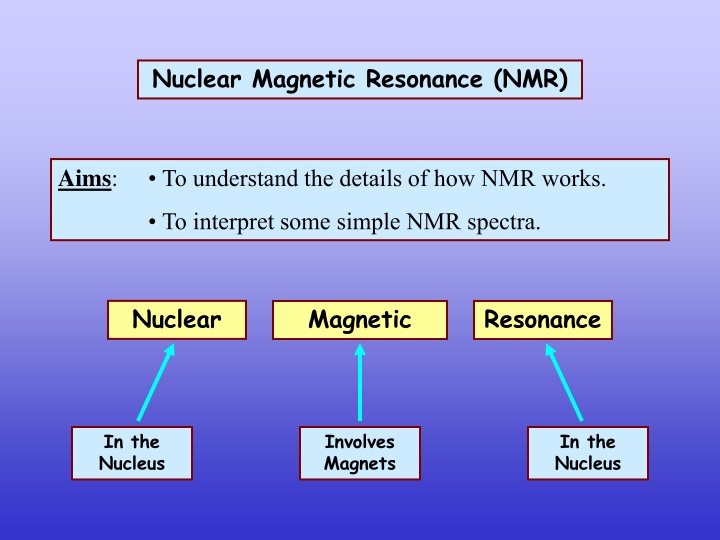
Nuclear Magnetic Resonance (NMR) for Chemical Analysis
Explore the principles of Nuclear Magnetic Resonance (NMR) spectroscopy and how it reveals vital information about hydrogen atoms in molecules. Learn how NMR works, interprets spectra, and analyzes organic compounds by detecting energy changes in magnetic nuclei.
Download Presentation

Please find below an Image/Link to download the presentation.
The content on the website is provided AS IS for your information and personal use only. It may not be sold, licensed, or shared on other websites without obtaining consent from the author. If you encounter any issues during the download, it is possible that the publisher has removed the file from their server.
You are allowed to download the files provided on this website for personal or commercial use, subject to the condition that they are used lawfully. All files are the property of their respective owners.
The content on the website is provided AS IS for your information and personal use only. It may not be sold, licensed, or shared on other websites without obtaining consent from the author.
E N D
Presentation Transcript
Nuclear Magnetic Resonance (NMR) Aims: To understand the details of how NMR works. To interpret some simple NMR spectra. Nuclear Magnetic Resonance In the Nucleus Involves Magnets In the Nucleus
But hydrogen isnt magnetic? In fact, the nucleus of a hydrogen atom has a very weak magnetic spin, it behaves like a weak compass needle. If a molecule containing hydrogen is placed in a strong magnetic field, the magnetic hydrogen nucleus can line up with the field or line up against it! Nucleus spin aligned with the field Low energy! N S S N Nucleus spin aligned against the field High energy! N S N S Which is the high energy orientation?
Excited state = High energy N S N S Add Energy Energy Released N S N S S N S N Aligned = Low Energy Back to low energy ground state When the spin falls back into line with the magnetic field it releases energy. We detect this energy and it provides information on: The environment of the hydrogen in the molecule How many hydrogen atoms are in that environment.
NMR is a very detailed method of chemical analysis for ORGANIC compounds. It can tell us the number of hydrogen atoms in a molecule and their related positions in the carbon chain. The nucleus of each hydrogen atom behaves like a tiny magnet, which usually lines up with an applied magnetic field. However, if we add energy, the tiny magnet can flip over so that it aligns against the magnetic field. When the external energy is removed, the magnetic nucleus must, once again, fall back in line with the magnetic field and release its extra energy. We detect this released energy and use it to gather information about the hydrogen which was excited.
1) The environment of the Hydrogen atom The frequency of energy needed to flip the magnet (Spin) is different for hydrogen atoms that are in different positions. Needs high frequency energy to flip here, so high frequency energy released when it flips back. H O H C C H H Flips quite easily needs low frequency energy. So the type of energy given off tells us the position of the hydrogen in the molecule.
2) How many hydrogen atoms are in each position If one hydrogen releases a set amount of energy when it falls back in line (eg 2 units). Then 3 hydrogen atoms will release 3 times that amount when they fall in line (6 units). This affects the size of the peak in the NMR spectrum. The more hydrogen atoms, the bigger the peak!
Interpreting NMR Spectra Counting Hydrogen environments One molecule can contain many hydrogen environments. Each environment will release a different frequency of energy when it drops down from its excited state to line up with the magnetic field. So for each different hydrogen environment, we will see a different peak in the NMR spectrum. H 2 x H environments so 2 peaks in NMR spectrum. O H C C H H
Your Turn! H CH3 2 x H environments so 2 peaks in NMR spectrum. C C H3C H 4 x H environments so 4 peaks in NMR spectrum. H2 C OH H3C C H2 3 x H environments so 3 peaks in NMR spectrum.
The positions of each peak in the NMR spectrum. Each different hydrogen environment will appear in a different position in the NMR spectrum. This is called Chemical Shift. The functional groups attached to the hydrogen have a great effect on the amount of energy needed to flip the spin. Functional groups with lots of electrons (Alkenes, Carbonyls and Carboxylic acids) push the position of the NMR peak up on the scale.
Quick reference for chemical shifts.(CI-p152) Chemical Shift Functional Group R CH3 0.8-1.2 Alkane H C 1.6 C CH3 2.3 Benzyl CH3 R C CH3 2.2 Carbonyl O R N CH3 2.3 Amine HO CH3 3.3 Alcohol H3C Cl 3.6 Alkyl Halide H2C CH2 4.5-6.0 Alkene 6.0-9.0 Benzene H 0.5-4.5 Alcohol R OH Very Broad O 9.0-15.0 Carbox. acid R OH
This powerpoint was kindly donated to www.worldofteaching.com http://www.worldofteaching.com is home to over a thousand powerpoints submitted by teachers. This is a completely free site and requires no registration. Please visit and I hope it will help in your teaching.

